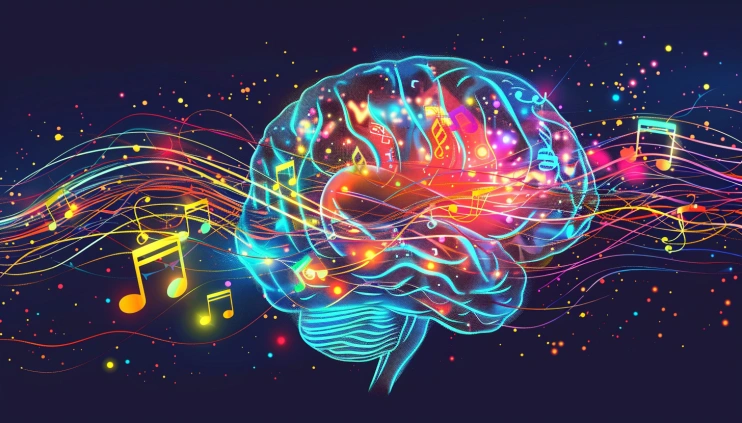The Role of Music in Entrainment intersects multiple disciplines in Neuroscience, Psychology, and Musicology

The interactive nature of musical entrainment underscores the universal appeal of music and its ability to enhance well-being.
Musicology provides insights into creating and experiencing music, highlighting its role in creativity and meaning-making through musical entrainment.

The intersection of neuroscience, psychology, and musicology reveals the profound impact of music on mental and emotional well-being.
Music activates areas of memory, attention, and emotion regulation in the brain. Psychological studies show music's ability to evoke memories, emotions, and enhance social interactions.
Listen to the audio Interview. Enjoy.
Musicology provides insights into creating and experiencing music, highlighting its role in creativity and meaning-making through musical entrainment. This interdisciplinary approach offers a unique perspective on the therapeutic potential of music.
Entrainment in the biomusicological sense refers to the synchronization (e.g. foot tapping) of organisms to an external perceived rhythm such as human music and dance. Humans are the only species for which all individuals experience entrainment(...)
Wikipedia.
Abstract
The interdisciplinary nature of studying the role of music in entrainment through neuroscience, psychology, and musicology offers valuable insights into the profound impact music has on mental and emotional well-being. This research delves into how listening to music activates various areas of the brain, such as memory, attention, and emotion regulation. It explores the emotional and cognitive effects of music, highlighting its therapeutic potential for conditions like depression and anxiety. Additionally, musicology provides a deeper understanding of how music is created and experienced, emphasizing concepts like pitch and rhythm perception. The interactive nature of musical entrainment underscores the universal appeal of music and its ability to enhance well-being.
Music Entrainment Importance
Introduction
Music has been a powerful tool for human expression and connection throughout history. Recent research at the intersection of neuroscience, psychology, and musicology has uncovered the profound impact music has on our mental and emotional well-being. This interdisciplinary approach allows us to delve into the intricate relationship between music and the brain, emotions, and behavior.
- Neuroscience studies have shown that listening to music activates various areas of the brain, enhancing memory, attention, and emotion regulation. This suggests that music can play a crucial role in therapeutic interventions for a range of conditions, from depression to stroke recovery.
- Psychological research has emphasized the emotional and cognitive effects of music, illustrating its ability to evoke memories, stimulate emotions, and improve social interactions. The therapeutic potential of music has been recognized for centuries, highlighting its significance in enhancing well-being.
- Musicology offers insights into the creation and experience of music as an art form. Concepts such as pitch perception, rhythm perception, and tonality perception demonstrate the intricacies of how our brains process musical information. Musical entrainment, where individuals synchronize their movements and emotions with music, showcases the interactive and creative nature of music.
The Role of Music in Entrainment
Music plays a significant role in entrainment by engaging with various disciplines such as neuroscience, psychology, and musicology. This interdisciplinary approach offers a diverse perspective on how music impacts our mental and emotional well-being.
Neuroscience Perspective
- Brain Activation
- Memory and Attention
Neuroscientific studies have demonstrated that music activates multiple areas of the brain, influencing memory retention and attention span. This suggests that music can be utilized as a tool to enhance cognitive functions and emotional regulation.
Psychological Perspective
- Emotional and Cognitive Effects
- Therapeutic Potential
Psychological research reveals that music has the ability to evoke emotions, trigger memories, and improve social interactions. The therapeutic potential of music has been recognized for its ability to aid in emotional well-being and alleviate mental health conditions.
Musicology Perspective
- Pitch and Rhythm Perception
- Musical Entrainment
Musicology uncovers the intricate components of music such as pitch perception and rhythm, highlighting how individuals synchronize their movements and emotions with musical stimuli. Musical entrainment underscores the interactive nature of music and its capacity for creativity and emotional connection.
Therapeutic and Rehabilitation Use
Exploring the benefits of Innerdance reveals a fascinating world of healing potential through music entrainment. Innerdance, a practice deeply rooted in the relationship between music and the mind, offers a unique approach to therapeutic experiences. The entrainment process, guided by rhythmic patterns and melodic structures, plays a crucial role in promoting relaxation and inner balance.
Innerdance Benefits
Innerdance is known for its ability to induce deep states of relaxation and emotional release, allowing individuals to access and process buried emotions. Through the power of music entrainment, Innerdance promotes holistic healing by synchronizing body, mind, and soul. The profound impact of Innerdance on individuals' well-being highlights the therapeutic potential of music as a tool for self-discovery and personal growth.
Music Entrainment
- Music entrainment involves the synchronization of brainwave frequencies with the rhythm and tempo of music. This process can significantly impact mood, cognitive function, and emotional well-being.
- By entraining the brain to the rhythmic patterns of music, individuals can experience altered states of consciousness, enhanced creativity, and increased relaxation.
Relationship with Music
The relationship between Innerdance and music is symbiotic. Music serves as the conduit through which entrainment occurs, guiding individuals on a transformative journey of self-exploration and healing. The emotional depth and sensory richness of music enhance the Innerdance experience, fostering profound connections between body, mind, and spirit.
Footnotes
- Music therapy has been increasingly utilized in various healthcare settings to improve patients' well-being and quality of life.
- Research has shown that music therapy can be effective in reducing stress, anxiety, and depression, particularly in individuals with neurological disorders.
- Studies have also highlighted the role of music in promoting physical rehabilitation and cognitive functioning in stroke survivors and individuals with traumatic brain injuries.
- Innerdance, a form of therapeutic movement practice, incorporates music entrainment to facilitate emotional release and self-discovery.
- The relationship between Innerdance benefits and music entrainment underscores the interconnectedness of music and movement in promoting holistic healing.
References
- Altenmüller, E., & Schlaug, G. (2013). Apollo's gift: New aspects of neurologic music therapy. Progress in brain research, 207, 237-54.
- Bach, S., & Spatz, C., et al. (2018). Music for insomnia therapy: A meta-analysis of systematic reviews. Journal of sleep research, 27(3), e12669.
- Patel, A. D. (2018). Why music? The cognitive neuroscience of music. Progress in brain research, 237, 243-60.
- Schlaug, G., & Norton, A., et al. (2009). Listening to music in stroke recovery. Annals of the New York Academy of Sciences, 1169(1), 426-430.

Leave a Reply